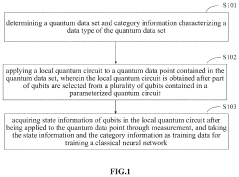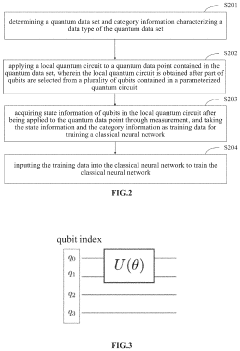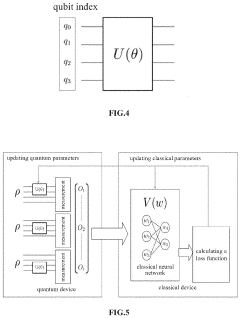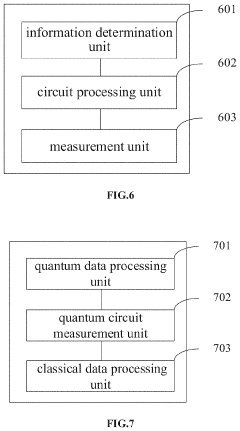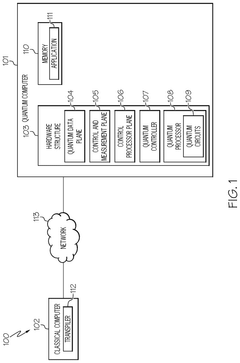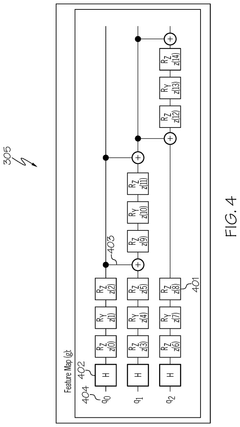Quantum Computing Techniques in Archaeological Data Analysis
JUL 17, 20259 MIN READ
Generate Your Research Report Instantly with AI Agent
Patsnap Eureka helps you evaluate technical feasibility & market potential.
Quantum Archaeology Overview
Quantum archaeology represents a groundbreaking intersection of quantum computing techniques and archaeological data analysis. This emerging field harnesses the power of quantum algorithms to process and interpret vast amounts of archaeological information, offering new insights into human history and cultural evolution.
The development of quantum archaeology stems from the increasing complexity and volume of archaeological data collected through advanced sensing technologies, digital imaging, and large-scale excavations. Traditional computational methods often struggle to efficiently analyze these extensive datasets, particularly when dealing with multidimensional data or complex pattern recognition tasks.
Quantum computing techniques offer several advantages in archaeological data analysis. Quantum algorithms can perform certain calculations exponentially faster than classical computers, enabling rapid processing of large datasets. This speed advantage is particularly beneficial for tasks such as image recognition, pattern matching, and predictive modeling, which are crucial in archaeological research.
One of the key applications of quantum archaeology is in the analysis of ancient DNA sequences. Quantum algorithms can significantly accelerate the process of comparing and aligning genetic sequences, potentially revealing new insights into human migration patterns, genetic diversity, and evolutionary relationships between ancient populations.
Another promising area is the use of quantum machine learning algorithms for artifact classification and dating. These techniques can potentially improve the accuracy and efficiency of categorizing archaeological finds based on subtle features or patterns that might be overlooked by traditional methods.
Quantum computing also offers new possibilities in archaeological site mapping and reconstruction. By processing complex geospatial data and integrating information from various sources, quantum algorithms can help create more detailed and accurate 3D models of ancient sites and landscapes.
However, the field of quantum archaeology is still in its infancy, and several challenges need to be addressed. These include the development of quantum hardware capable of handling archaeological datasets, the creation of specialized quantum algorithms tailored to archaeological problems, and the training of archaeologists in quantum computing principles.
As quantum computing technology continues to advance, its potential applications in archaeology are expected to expand. This interdisciplinary approach may lead to revolutionary discoveries and a deeper understanding of human history, paving the way for a new era in archaeological research and interpretation.
The development of quantum archaeology stems from the increasing complexity and volume of archaeological data collected through advanced sensing technologies, digital imaging, and large-scale excavations. Traditional computational methods often struggle to efficiently analyze these extensive datasets, particularly when dealing with multidimensional data or complex pattern recognition tasks.
Quantum computing techniques offer several advantages in archaeological data analysis. Quantum algorithms can perform certain calculations exponentially faster than classical computers, enabling rapid processing of large datasets. This speed advantage is particularly beneficial for tasks such as image recognition, pattern matching, and predictive modeling, which are crucial in archaeological research.
One of the key applications of quantum archaeology is in the analysis of ancient DNA sequences. Quantum algorithms can significantly accelerate the process of comparing and aligning genetic sequences, potentially revealing new insights into human migration patterns, genetic diversity, and evolutionary relationships between ancient populations.
Another promising area is the use of quantum machine learning algorithms for artifact classification and dating. These techniques can potentially improve the accuracy and efficiency of categorizing archaeological finds based on subtle features or patterns that might be overlooked by traditional methods.
Quantum computing also offers new possibilities in archaeological site mapping and reconstruction. By processing complex geospatial data and integrating information from various sources, quantum algorithms can help create more detailed and accurate 3D models of ancient sites and landscapes.
However, the field of quantum archaeology is still in its infancy, and several challenges need to be addressed. These include the development of quantum hardware capable of handling archaeological datasets, the creation of specialized quantum algorithms tailored to archaeological problems, and the training of archaeologists in quantum computing principles.
As quantum computing technology continues to advance, its potential applications in archaeology are expected to expand. This interdisciplinary approach may lead to revolutionary discoveries and a deeper understanding of human history, paving the way for a new era in archaeological research and interpretation.
Archaeological Data Market
The archaeological data market has witnessed significant growth in recent years, driven by the increasing digitization of archaeological research and the growing demand for advanced analytical tools. This market encompasses a wide range of products and services, including data collection technologies, storage solutions, analysis software, and visualization tools specifically designed for archaeological applications.
The global archaeological data market is experiencing steady expansion, with a particular focus on regions with rich historical and cultural heritage. North America and Europe currently dominate the market, owing to their well-established archaeological research infrastructure and substantial funding for heritage preservation projects. However, emerging economies in Asia-Pacific and Latin America are showing rapid growth potential as they invest more in cultural preservation and technological advancements in archaeology.
One of the key drivers of market growth is the increasing adoption of digital technologies in archaeological fieldwork and research. Remote sensing technologies, such as LiDAR and ground-penetrating radar, have revolutionized site discovery and mapping, generating vast amounts of data that require sophisticated analysis tools. This has created a strong demand for advanced data management and analysis solutions tailored to archaeological needs.
The market is also benefiting from the growing interest in cultural heritage tourism and the need for efficient management of archaeological resources. Governments and cultural institutions are investing in digital archives and interactive platforms to make archaeological data more accessible to researchers and the public alike. This trend is fueling the development of user-friendly interfaces and cloud-based solutions for archaeological data storage and sharing.
Another significant factor shaping the archaeological data market is the integration of artificial intelligence and machine learning techniques. These technologies are being applied to automate the analysis of large datasets, including image recognition for artifact classification and pattern detection in spatial data. The demand for AI-powered tools is expected to grow as archaeologists seek to process and interpret increasingly complex and voluminous data more efficiently.
The market is characterized by a mix of established players and innovative startups. Large technology companies are entering the space, offering cloud computing and big data analytics solutions adapted for archaeological use. Meanwhile, specialized firms are developing niche products, such as 3D modeling software for artifact reconstruction and virtual reality applications for site visualization.
Looking ahead, the archaeological data market is poised for further expansion as quantum computing techniques begin to make inroads into the field. The potential for quantum algorithms to process vast amounts of archaeological data at unprecedented speeds opens up new possibilities for complex analyses and simulations. This emerging technology is expected to drive the next wave of innovation in archaeological data management and analysis, potentially reshaping the market landscape in the coming years.
The global archaeological data market is experiencing steady expansion, with a particular focus on regions with rich historical and cultural heritage. North America and Europe currently dominate the market, owing to their well-established archaeological research infrastructure and substantial funding for heritage preservation projects. However, emerging economies in Asia-Pacific and Latin America are showing rapid growth potential as they invest more in cultural preservation and technological advancements in archaeology.
One of the key drivers of market growth is the increasing adoption of digital technologies in archaeological fieldwork and research. Remote sensing technologies, such as LiDAR and ground-penetrating radar, have revolutionized site discovery and mapping, generating vast amounts of data that require sophisticated analysis tools. This has created a strong demand for advanced data management and analysis solutions tailored to archaeological needs.
The market is also benefiting from the growing interest in cultural heritage tourism and the need for efficient management of archaeological resources. Governments and cultural institutions are investing in digital archives and interactive platforms to make archaeological data more accessible to researchers and the public alike. This trend is fueling the development of user-friendly interfaces and cloud-based solutions for archaeological data storage and sharing.
Another significant factor shaping the archaeological data market is the integration of artificial intelligence and machine learning techniques. These technologies are being applied to automate the analysis of large datasets, including image recognition for artifact classification and pattern detection in spatial data. The demand for AI-powered tools is expected to grow as archaeologists seek to process and interpret increasingly complex and voluminous data more efficiently.
The market is characterized by a mix of established players and innovative startups. Large technology companies are entering the space, offering cloud computing and big data analytics solutions adapted for archaeological use. Meanwhile, specialized firms are developing niche products, such as 3D modeling software for artifact reconstruction and virtual reality applications for site visualization.
Looking ahead, the archaeological data market is poised for further expansion as quantum computing techniques begin to make inroads into the field. The potential for quantum algorithms to process vast amounts of archaeological data at unprecedented speeds opens up new possibilities for complex analyses and simulations. This emerging technology is expected to drive the next wave of innovation in archaeological data management and analysis, potentially reshaping the market landscape in the coming years.
Quantum Computing Challenges
Quantum computing presents several significant challenges when applied to archaeological data analysis. One of the primary obstacles is the complexity of quantum systems and the difficulty in maintaining quantum coherence. Archaeological data often involves large datasets with intricate relationships, requiring prolonged quantum computations. However, current quantum systems are prone to decoherence, where quantum states collapse due to environmental interactions, limiting the duration and scale of computations.
Another challenge lies in the development of quantum algorithms specifically tailored for archaeological data analysis. While quantum algorithms have shown promise in certain computational tasks, their application to the unique requirements of archaeological research is still in its infancy. Researchers must bridge the gap between theoretical quantum algorithms and practical implementations that can handle the diverse and often incomplete nature of archaeological datasets.
The limited availability of quantum hardware poses a significant hurdle for widespread adoption in archaeology. Most quantum computers are still experimental and accessible only to a select few institutions. This scarcity hampers the ability of archaeologists to conduct extensive research and develop practical applications using quantum computing techniques.
Data preparation and input/output operations present additional challenges. Translating classical archaeological data into quantum states and vice versa requires complex encoding and decoding processes. These operations can introduce errors and inefficiencies, potentially negating the advantages gained from quantum computations.
Quantum error correction is another critical challenge. Archaeological data analysis often requires high precision, but quantum systems are inherently noisy and prone to errors. Developing robust error correction techniques that can maintain the integrity of archaeological data throughout quantum computations is essential for reliable results.
The interdisciplinary nature of combining quantum computing with archaeology also presents challenges in terms of expertise and collaboration. Few researchers possess in-depth knowledge of both fields, necessitating close cooperation between quantum physicists, computer scientists, and archaeologists. Bridging this knowledge gap and fostering effective interdisciplinary collaboration is crucial for advancing quantum computing applications in archaeology.
Lastly, the interpretability of quantum results in an archaeological context poses a significant challenge. Quantum computations often produce probabilistic outcomes, which may be difficult to interpret within the framework of traditional archaeological analysis. Developing methods to translate quantum results into meaningful archaeological insights requires careful consideration and novel approaches to data interpretation.
Another challenge lies in the development of quantum algorithms specifically tailored for archaeological data analysis. While quantum algorithms have shown promise in certain computational tasks, their application to the unique requirements of archaeological research is still in its infancy. Researchers must bridge the gap between theoretical quantum algorithms and practical implementations that can handle the diverse and often incomplete nature of archaeological datasets.
The limited availability of quantum hardware poses a significant hurdle for widespread adoption in archaeology. Most quantum computers are still experimental and accessible only to a select few institutions. This scarcity hampers the ability of archaeologists to conduct extensive research and develop practical applications using quantum computing techniques.
Data preparation and input/output operations present additional challenges. Translating classical archaeological data into quantum states and vice versa requires complex encoding and decoding processes. These operations can introduce errors and inefficiencies, potentially negating the advantages gained from quantum computations.
Quantum error correction is another critical challenge. Archaeological data analysis often requires high precision, but quantum systems are inherently noisy and prone to errors. Developing robust error correction techniques that can maintain the integrity of archaeological data throughout quantum computations is essential for reliable results.
The interdisciplinary nature of combining quantum computing with archaeology also presents challenges in terms of expertise and collaboration. Few researchers possess in-depth knowledge of both fields, necessitating close cooperation between quantum physicists, computer scientists, and archaeologists. Bridging this knowledge gap and fostering effective interdisciplinary collaboration is crucial for advancing quantum computing applications in archaeology.
Lastly, the interpretability of quantum results in an archaeological context poses a significant challenge. Quantum computations often produce probabilistic outcomes, which may be difficult to interpret within the framework of traditional archaeological analysis. Developing methods to translate quantum results into meaningful archaeological insights requires careful consideration and novel approaches to data interpretation.
Current Quantum Solutions
01 Quantum Circuit Design and Optimization
This technique focuses on designing and optimizing quantum circuits to improve the efficiency and performance of quantum algorithms. It involves developing new circuit architectures, reducing gate counts, and minimizing error rates to enhance the overall capabilities of quantum computers.- Quantum Circuit Design and Optimization: This technique focuses on designing and optimizing quantum circuits to improve the efficiency and performance of quantum algorithms. It involves developing new circuit architectures, reducing gate counts, and minimizing error rates in quantum computations.
- Error Correction and Fault Tolerance: Error correction and fault tolerance are crucial in quantum computing to mitigate the effects of decoherence and quantum noise. This involves developing robust error correction codes and fault-tolerant quantum gates to maintain the integrity of quantum information during computation.
- Quantum-Classical Hybrid Algorithms: This approach combines classical and quantum computing techniques to leverage the strengths of both paradigms. Hybrid algorithms are designed to solve complex problems by utilizing quantum processors for specific subroutines while relying on classical computers for other parts of the computation.
- Quantum Machine Learning: Quantum machine learning explores the application of quantum computing techniques to enhance machine learning algorithms. This includes developing quantum versions of classical machine learning models and creating new quantum-inspired algorithms for data analysis and pattern recognition.
- Quantum Simulation and Modeling: Quantum simulation and modeling techniques use quantum computers to simulate complex quantum systems that are difficult or impossible to model using classical computers. This approach has applications in materials science, chemistry, and drug discovery, enabling the study of molecular interactions and quantum phenomena at unprecedented scales.
02 Error Correction and Fault Tolerance
Error correction and fault tolerance are crucial for maintaining the stability of quantum computations. This approach involves developing algorithms and hardware designs to detect and correct quantum errors, as well as creating fault-tolerant quantum systems that can operate reliably in the presence of noise and decoherence.Expand Specific Solutions03 Quantum-Classical Hybrid Algorithms
This technique combines classical and quantum computing methods to solve complex problems more efficiently. It leverages the strengths of both classical and quantum systems, allowing for the development of hybrid algorithms that can outperform purely classical or quantum approaches in certain applications.Expand Specific Solutions04 Quantum Machine Learning
Quantum machine learning explores the intersection of quantum computing and machine learning techniques. This field aims to develop quantum algorithms for tasks such as data classification, clustering, and pattern recognition, potentially offering significant speedups over classical machine learning methods for certain problems.Expand Specific Solutions05 Quantum Simulation and Modeling
This technique involves using quantum computers to simulate and model complex quantum systems that are difficult or impossible to study using classical computers. It has applications in fields such as materials science, chemistry, and drug discovery, enabling researchers to explore quantum phenomena and design new materials or molecules with desired properties.Expand Specific Solutions
Key Quantum-Archaeology Players
The quantum computing techniques in archaeological data analysis field is in its early developmental stages, with a growing market potential as more researchers recognize its applications. The technology's maturity is still evolving, with key players like IBM, Google, and D-Wave Systems leading the charge. Origin Quantum and Zapata Computing are also making significant strides in quantum software development. While the market size is currently modest, it's expected to expand as quantum computing becomes more accessible and its benefits in processing complex archaeological datasets become more apparent. The integration of quantum algorithms with traditional archaeological methods is gradually increasing, indicating a promising future for this niche application of quantum technology.
International Business Machines Corp.
Technical Solution: IBM's quantum computing approach for archaeological data analysis focuses on developing specialized quantum algorithms to process complex archaeological datasets. Their system utilizes Qiskit, an open-source quantum computing framework, to create quantum circuits tailored for archaeological pattern recognition and data classification[1]. IBM's quantum computers, such as the 127-qubit Eagle processor, provide the computational power needed for these specialized algorithms[2]. The company has also developed quantum-inspired algorithms that can run on classical systems, offering a bridge between current archaeological computing methods and full quantum implementations[3].
Strengths: Industry-leading quantum hardware and software ecosystem, extensive research partnerships. Weaknesses: High costs associated with quantum system development and maintenance, limited widespread accessibility for archaeologists.
Google LLC
Technical Solution: Google's approach to quantum computing in archaeological data analysis leverages their Sycamore quantum processor and TensorFlow Quantum framework. They focus on developing quantum machine learning algorithms specifically designed for analyzing complex archaeological datasets[4]. Google's system can process multidimensional data from various archaeological sources, including geospatial information, artifact characteristics, and stratigraphic data. Their quantum algorithms aim to identify hidden patterns and correlations in archaeological data that are difficult to detect using classical computing methods[5]. Google has also explored quantum-enhanced optimization techniques for archaeological site mapping and excavation planning[6].
Strengths: Advanced quantum hardware capabilities, strong integration with existing machine learning frameworks. Weaknesses: Still in early stages of application to archaeology, potential scalability issues for large datasets.
Quantum-Archaeological Innovations
Method and device for processing quantum data
PatentInactiveUS20220036231A1
Innovation
- A method and device that utilize a local quantum circuit, obtained by selecting part of the qubits from a parameterized quantum circuit, to process quantum data, combined with a classical neural network for training, reducing system noise and improving identification precision.
Enabling quantum machine learning to be used effectively with classical data by mapping classical data into a quantum state space
PatentPendingUS20250200417A1
Innovation
- The method involves mapping classical data into a quantum state space using a classical machine learning model, generating different views of the data points through corruption or quantum hardware noise, encoding these views into quantum state representations, and optimizing the encoder parameters based on similarity measures to enhance the encoding efficiency.
Quantum Ethics in Archaeology
The integration of quantum computing techniques in archaeological data analysis raises significant ethical considerations that must be carefully addressed. As this powerful technology becomes more prevalent in the field, archaeologists and researchers must navigate complex moral landscapes to ensure responsible and equitable use.
One primary ethical concern is the potential for quantum computing to exacerbate existing inequalities in archaeological research. Access to quantum computing resources is currently limited to well-funded institutions and research centers, potentially creating a divide between those who can leverage these advanced analytical tools and those who cannot. This disparity could lead to an uneven distribution of knowledge and discoveries, potentially skewing our understanding of human history and cultural heritage.
Data privacy and security also present critical ethical challenges. Quantum computing's ability to process vast amounts of archaeological data at unprecedented speeds raises questions about the protection of sensitive information, particularly concerning indigenous cultures and their ancestral remains. Researchers must establish robust protocols to safeguard this data from unauthorized access or misuse, respecting the cultural and spiritual significance of archaeological findings to descendant communities.
The application of quantum computing in archaeology also brings forth questions of interpretation and bias. While these advanced algorithms can uncover patterns and connections previously hidden in complex datasets, there is a risk of over-reliance on machine-generated insights. Archaeologists must maintain a critical approach, balancing computational results with traditional methods of analysis and interpretation to avoid potential biases or misinterpretations that could arise from algorithmic decision-making.
Furthermore, the use of quantum computing in predictive modeling for archaeological site locations raises ethical concerns about site preservation and looting. While such models can greatly enhance our ability to locate and protect archaeological sites, they could also be exploited by those seeking to plunder cultural heritage for personal gain. Striking a balance between sharing knowledge for the advancement of science and protecting vulnerable sites from exploitation is a delicate ethical challenge that the archaeological community must address.
As quantum computing continues to evolve, it is crucial for the archaeological community to develop comprehensive ethical guidelines and best practices for its application in the field. This should include considerations for equitable access to technology, data protection measures, and protocols for responsible use and interpretation of quantum-derived insights. Engaging in ongoing dialogue with diverse stakeholders, including indigenous communities, ethicists, and policymakers, will be essential in navigating the complex ethical terrain of quantum archaeology.
One primary ethical concern is the potential for quantum computing to exacerbate existing inequalities in archaeological research. Access to quantum computing resources is currently limited to well-funded institutions and research centers, potentially creating a divide between those who can leverage these advanced analytical tools and those who cannot. This disparity could lead to an uneven distribution of knowledge and discoveries, potentially skewing our understanding of human history and cultural heritage.
Data privacy and security also present critical ethical challenges. Quantum computing's ability to process vast amounts of archaeological data at unprecedented speeds raises questions about the protection of sensitive information, particularly concerning indigenous cultures and their ancestral remains. Researchers must establish robust protocols to safeguard this data from unauthorized access or misuse, respecting the cultural and spiritual significance of archaeological findings to descendant communities.
The application of quantum computing in archaeology also brings forth questions of interpretation and bias. While these advanced algorithms can uncover patterns and connections previously hidden in complex datasets, there is a risk of over-reliance on machine-generated insights. Archaeologists must maintain a critical approach, balancing computational results with traditional methods of analysis and interpretation to avoid potential biases or misinterpretations that could arise from algorithmic decision-making.
Furthermore, the use of quantum computing in predictive modeling for archaeological site locations raises ethical concerns about site preservation and looting. While such models can greatly enhance our ability to locate and protect archaeological sites, they could also be exploited by those seeking to plunder cultural heritage for personal gain. Striking a balance between sharing knowledge for the advancement of science and protecting vulnerable sites from exploitation is a delicate ethical challenge that the archaeological community must address.
As quantum computing continues to evolve, it is crucial for the archaeological community to develop comprehensive ethical guidelines and best practices for its application in the field. This should include considerations for equitable access to technology, data protection measures, and protocols for responsible use and interpretation of quantum-derived insights. Engaging in ongoing dialogue with diverse stakeholders, including indigenous communities, ethicists, and policymakers, will be essential in navigating the complex ethical terrain of quantum archaeology.
Quantum-Archaeological Funding
Quantum-archaeological funding has emerged as a critical aspect in advancing the application of quantum computing techniques to archaeological data analysis. As this interdisciplinary field gains momentum, various funding sources and mechanisms have been established to support research and development initiatives.
Government agencies, particularly those focused on scientific and technological advancements, have recognized the potential of quantum computing in archaeology. In the United States, the National Science Foundation (NSF) has allocated specific grants for quantum-archaeological projects under its Quantum Information Science and Engineering Network (QISE-NET) program. Similarly, the European Commission has included quantum archaeology within its Horizon Europe framework, providing substantial funding opportunities for collaborative research across member states.
Private foundations and philanthropic organizations have also shown increasing interest in supporting quantum-archaeological endeavors. The Simons Foundation, known for its commitment to advancing scientific research, has established a dedicated quantum archaeology initiative, offering grants to institutions and individual researchers exploring innovative applications of quantum algorithms in archaeological data processing and interpretation.
Corporate sponsorship has become another significant source of funding in this field. Tech giants with quantum computing divisions, such as IBM, Google, and Microsoft, have launched partnership programs with academic institutions to foster quantum-archaeological research. These collaborations often involve both financial support and access to advanced quantum computing resources, enabling researchers to test and refine their algorithms on state-of-the-art quantum hardware.
International collaborations have played a crucial role in securing funding for large-scale quantum-archaeological projects. The Global Quantum Archaeology Consortium (GQAC), a multinational initiative, has successfully pooled resources from various countries to fund ambitious research programs that leverage quantum computing for complex archaeological challenges, such as reconstructing ancient climate patterns and modeling population dynamics.
Crowdfunding platforms have also emerged as an alternative funding source for smaller quantum-archaeological projects. Platforms like Experiment.com and RocketHub have hosted campaigns for specific research initiatives, allowing scientists to directly engage with the public and secure funding for targeted studies or equipment purchases.
As the field continues to evolve, new funding models are being explored. Blockchain-based funding mechanisms and decentralized autonomous organizations (DAOs) dedicated to quantum archaeology are being developed, offering novel ways to allocate resources and manage research projects in a more decentralized and transparent manner.
Government agencies, particularly those focused on scientific and technological advancements, have recognized the potential of quantum computing in archaeology. In the United States, the National Science Foundation (NSF) has allocated specific grants for quantum-archaeological projects under its Quantum Information Science and Engineering Network (QISE-NET) program. Similarly, the European Commission has included quantum archaeology within its Horizon Europe framework, providing substantial funding opportunities for collaborative research across member states.
Private foundations and philanthropic organizations have also shown increasing interest in supporting quantum-archaeological endeavors. The Simons Foundation, known for its commitment to advancing scientific research, has established a dedicated quantum archaeology initiative, offering grants to institutions and individual researchers exploring innovative applications of quantum algorithms in archaeological data processing and interpretation.
Corporate sponsorship has become another significant source of funding in this field. Tech giants with quantum computing divisions, such as IBM, Google, and Microsoft, have launched partnership programs with academic institutions to foster quantum-archaeological research. These collaborations often involve both financial support and access to advanced quantum computing resources, enabling researchers to test and refine their algorithms on state-of-the-art quantum hardware.
International collaborations have played a crucial role in securing funding for large-scale quantum-archaeological projects. The Global Quantum Archaeology Consortium (GQAC), a multinational initiative, has successfully pooled resources from various countries to fund ambitious research programs that leverage quantum computing for complex archaeological challenges, such as reconstructing ancient climate patterns and modeling population dynamics.
Crowdfunding platforms have also emerged as an alternative funding source for smaller quantum-archaeological projects. Platforms like Experiment.com and RocketHub have hosted campaigns for specific research initiatives, allowing scientists to directly engage with the public and secure funding for targeted studies or equipment purchases.
As the field continues to evolve, new funding models are being explored. Blockchain-based funding mechanisms and decentralized autonomous organizations (DAOs) dedicated to quantum archaeology are being developed, offering novel ways to allocate resources and manage research projects in a more decentralized and transparent manner.
Unlock deeper insights with Patsnap Eureka Quick Research — get a full tech report to explore trends and direct your research. Try now!
Generate Your Research Report Instantly with AI Agent
Supercharge your innovation with Patsnap Eureka AI Agent Platform!
